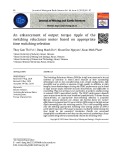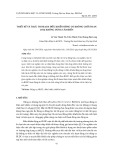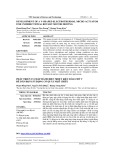
CÔNG NGHỆ https://jst-haui.vn Tạp chí Khoa học và Công nghệ Trường Đại học Công nghiệp Hà Nội Tập 60 - Số 9 (9/2024)
26
KHOA H
ỌC
P
-
ISSN 1859
-
3585
E
-
ISSN 2615
-
961
9
THE ADAPTIVE SPEED TRACKING CONTROLLER FOR INTELLIGENT ELECTRIC VEHICLES USING WFCMAC INCLUDES CAR-FOLLOWING BEHAVIOR, IMPROVING SAFETY AND ENERGY EFFICIENCY
BỘ ĐIỀU KHIỂN BÁM ĐUỔI TỐC ĐỘ THÍCH NGHI CHO XE ĐIỆN THÔNG MINH SỬ DỤNG WFCMAC CÓ TÍNH ĐẾN HÀNH VI BÁM THEO Ô TÔ, NÂNG CAO ĐỘ AN TOÀN VÀ HIỆU QUẢ NĂNG LƯỢNG Tran Thanh Hai1,*, Ngo Thanh Quyen2, Nguyen Tho Van2, Phan Minh Than2, Nguyen Van Sy3, Le Tong Tan Hoa2, Bui Thi Cam Quynh2 DOI: http://doi.org/10.57001/huih5804.2024.289 ABSTRACT Intelligent electric vehicles (IEVs) are increasingly being developed due to their high safety, energy-saving, and environmental
friendliness. This research
proposes an adaptive speed control method, especially considering the braking system of intelligent electric vehicles. The st
udy aims to improve the safety and
energy savings of IEVs during vehicle operation. First, the article
builds a nonlinear dynamic model for IEVs, including electric motors, gearboxes, and braking
systems. Then, an IEV acceleration controller will be designed using the Wavelet Function Cerebellar Model Articulation Contr
oller (WFCMAC) to approximate
the desired target. In addition, the paper also proposes a new regenerative braking strategy to maximize braking energy. Simulation r
esults show that the
proposed control system effectively keeps up speed and conserves braking energy while maintaining IEV's operational safety. Keywords: Intelligent electric vehicles; regenerative braking; energy efficiency; Wavelet Function Cerebellar Model Articulation Controller; adaptive control. TÓM TẮT Các phương tiện xe điện thông minh (IEVs) ngày càng được phát triển do tính an toàn cao, tiết kiệm năng lượng và thân thiện với môi trườ
ng. Nghiên
cứu này đề xuất phương pháp điều khiển thích nghi tốc độ, đặc biệt xét đến hệ thống phanh của xe điện thông minh. Nghiên cứu nhằm mục đích cải thiệ
n
sự an toàn và tiết kiệm năng lượng của IEVs trong quá trình vận hành xe. Đầu tiên, bài báo xây dựng mô hình động học phi tuyến cho IEVs, bao gồm độ
ng
cơ điện, hộp số và hệ thống phanh. Sau đó, thiết kế một bộ điều khiển gia tốc IEV bằng phương pháp mạng điều khiển khớp nối mô hình tiểu não sử dụ
ng
hàm Wavelet (WFCMAC) để xấp xỉ mục tiêu mong muốn. Ngoài ra, bài báo còn đề xuất một chiến lược phanh tái tạo mới để tối đa hóa năng lượ
ng phanh.
Kết quả mô phỏng chỉ ra phương pháp đề xuất có hiệu quả tốt trong việc bám đuổi tốc độ và bảo toàn năng lượng phanh nhưng vẫn giữ tính an toàn vậ
n
hành của IEV. Từ khoá: Xe điện thông minh; phanh tái tạo; hiệu suất năng lượng; mạng điều khiển khớp nối mô hình tiểu não sử dụng hàm Wavelet; điều khiển thích nghi. 1Office of Planning and Investment, Industrial University of Ho Chi Minh City, Vietnam 2Faculty of Electrical Engineering Technology, Industrial University of Ho Chi Minh City, Vietnam 3Faculty of Automotive Engineering Technology, Industrial University of Ho Chi Minh City, Vietnam *Email: tranthanhhai@iuh.edu.vn Received: 15/4/2024 Revised: 02/6/2024 Accepted: 27/9/2024

P-ISSN 1859-3585 E-ISSN 2615-9619 https://jst-haui.vn SCIENCE - TECHNOLOGY Vol. 60 - No. 9 (Sep 2024) HaUI Journal of Science and Technology 27
1. INTRODUCTION Adaptive Cruise Control (ACC) adjusts vehicle speed based on traffic conditions [1, 2], aiming for safety and energy efficiency [3, 6]. However, balancing these objectives is challenging due to dynamic traffic. Machine learning algorithms like Model Predictive Control (MPC) have been explored to enhance ACC [7, 10] but face issues with unstable driving conditions. Consequently, there's a need for faster adaptive control systems for ACC. Frequent braking and acceleration in driving consume significant energy [11]. Regenerative Braking Systems (RBS) are crucial for improving energy efficiency, particularly with ACC. Optimizing energy recovery during braking is essential, with some studies suggesting using fuzzy logic for this purpose [12, 15]. This paper contributes to developing control systems for autonomous electric vehicles (IEVs) by creating a decentralized ACC system combined with RBS. The main contributions of this paper include: 1. Hierarchical ACC control system: The study has proposed a non-linear hierarchical control system, combining both the automatic cruise control system (ACC) and the regenerative braking system (RBS), which helps improve energy efficiency and ensure the safety of IEVs in various traffic situations. 2. CMAC model and Wavelet function: The study has applied a CMAC control model combined with Wavelet function to control IEVs and achieve desired states, providing a new and effective approach to controlling IEVs in autonomous vehicles. The organization of this research paper unfolds as follows: Part 2 elucidates the nonlinear dynamic model of IEV. Part 3 delineates the hierarchical ACC control structure tailored for IEVs. Part 4 entails the execution of simulation experiments. Ultimately, Part 5 encapsulates the drawn conclusions. 2. THE NONLINEAR DYNAMIC MODEL OF IEV Fig. 1 depicts the kinematics and control system of the IEV, including radar, AC induction motor (ACIM) active front axle control, power converter, speed transmission, and braking system on four wheels [16]. 2.1. Vehicle Dynamics Model Fig. 2 describes the vehicle dynamic model, which includes the front wheel's angular velocity (ωf), the rear wheel's angular velocity (ωr), and the actual speed in the vehicle's direction (vh).
hxfxrres
fftxfbf
rrxrbr
v=2F+2FF
JωT
m...-
.=--FTr.-.=r.-JωFT
(1) Fig. 1. Structural diagram of IEV where, Fxf and Fxr represent the axial traction of the front and rear wheels,
f
J
and
r
J
are the rotational inertia,
tmgg0
T=..T
ηi.i
is the driving torque, ηg is the total efficiency of the gearbox and drive, ig is the gear ratio of the gearbox, i0 is the transmission ratio, r is the wheel radius, Tm is the torque from ACIM, bf
μfgen
F-
T
=μT and br
μr
T=
μ
F
are the braking torques, gen
μf
=
F
μ
T is the regenerative braking torque.
cos
mg
mg
sin
mg
g
h
xr
F
zr
F
xf
F
zf
F
h
v
a
b
l
res
F
bf
T
t
T
br
T
Fig. 2. Longitudinal dynamic model Fres is the sum of various components of resistance forces that may occur in reality: d
2
h
res=mg(f cosθ+sFcin
θ).5Αρ
v
+0 (2) where, A is the vehicle frontal area, m is the vehicle's mass, f is the rolling friction coefficient, g is the gravitational acceleration, ρ is the air density, cd is the aerodynamic resistance coefficient, and θ is the slope of the road.

CÔNG NGHỆ https://jst-haui.vn Tạp chí Khoa học và Công nghệ Trường Đại học Công nghiệp Hà Nội Tập 60 - Số 9 (9/2024)
28
KHOA H
ỌC
P
-
ISSN 1859
-
3585
E
-
ISSN 2615
-
961
9
2.2. Tired Dynamics Model The force acts on the front Fxf and rear tires Fxr can be expressed as follows: xiiii
r
FDsin{C arctan[BλEBλr=-()actanBλ] -()}
i=f,
(3) λf and λr are the slip coefficients : iii
=(r-)/(r,)
λωvmaxωv
(4) Tire longitudinal force coefficients B, C, D, E are defined as follows: 5zi22zizibF2
34zi
01zi682z7zii
bFbF
Cr=bD=bFbFB=C+
;
DeE=bFb
+; ;
++ i=Ff, b (5) Fzf and Fzr is the normal tire force : zfgzrg
mm
Fgbvh;Fgavh
2l
=(-)=-
l2
()
(6) where, l is the wheelbase, hg is the height of the center of gravity, a and b are the distance from the center of gravity to the front and rear axles. 2.3. ACIM Dynamics Model The torque response of ACIM approximates a first-order process [17]:
mdes
mTτ
T
+11=s (7) 3. DESIGN OF HIERARCHICAL CONTROLLER Fig. 3. ACC hierarchical control structure The ACC model depicted in Fig. 3 is defined as follows: hLhL122ffhdesL
h
Kd=vaav
1
ΔΔ-(τ+τ).+τ.-=aaaa; Δ; =
a
T.-
T
(8) where, Δd = d - dsafe is the distance error, Δv = vf - vh is the speed error, d is the actual distance, ades is the desired acceleration, af is the actual acceleration of the ahead vehicle, ah is the actual acceleration of the after vehicle. KL and TL is based on the empirical values of relevant vehicle models [18]. The safe distance between vehicles is based on the speed of the driving vehicle and a constant time gap:
safe1h2hfmin
dvvv=
τ.+τ.(-)+d
(9) where, dsafe is a safe distance, dmin is the minimum safe distance between vehicles, vh is the speed of the after vehicle, vf is the speed of the vehicle in front, τ1 and τ2 are positive constants found in [19]. The ACC model can be delineated as follows:
00
F(x)G(x)uL(x)
xxy
(10) where,
T
h
xΔ
d,v,
[
a
Δ]
, u = ades, y is the system output,
L(x)
is an uncertain component. For example, 0
F(x)
and 0
G(x)
are the identified nonlinear vector of the system and are used to model the system. Therefore, the nonlinear system (10) can be controlled and 10
G(x)
exists for all
x.
The system tracking error is determined as follows: d
eyy
(11) The system tracking error vector is defined as follows:
T
TT(n1)Teeee
(12) The tracking error of the system is represented in vector form as follows:
n1n21tn1n0setetζet
ζetζetdt
(13) where,
T
12k
ssss
with i = 1, 2, 3,…, n. ζi is assumed to satisfy the Hurwitz polynomial.
ACC
ijk
Sliding
Surface
(eq. 13)
WFCMAC
(eq. 20)
S
u
WFCMAC
ˆ
w
Gauss function
parameter update rule
(eq. 23, 24)
The Weight
Memory Law
(eq. 21)
w
ijk
m
S
Robust Control
(eq. 22)
+
S
u
Robust
m
+
Traction Controller
Regenerative Braking
Controller
Ahead
Vehicle
Regenerative Braking
Low-Level Controller
a
des
T
des
d
des
_
+
d
Hierarchical Controller
T
gen,
T
bf,
T
br
d
After
Vehicle
WFCMAC High-Level Controller
v
f
v
h
v
f
v
h

P-ISSN 1859-3585 E-ISSN 2615-9619 https://jst-haui.vn SCIENCE - TECHNOLOGY Vol. 60 - No. 9 (Sep 2024) HaUI Journal of Science and Technology 29
If 0
F(x)
, 0
G(x)
and
L(x)
are precisely known, the ideal controller can be designed as follows: 1TIDEAL0d0
uG(x)F(x)L(x)Ke.
x
(14) where,
TTT
1n
K[KK]
is a positive constant matrix. However,
L(x)
is indeterminate for practical applications. Therefore, uIDEAL in (14) cannot be determined. This study proposes a control system consisting of a WFCMAC intelligent approximator and a robust controller:
OPPROXIMATIONROBUST
uuu (15) where,
OPPROXIMATION
u is the main controller used to approximate the ideal controller; the robust controller
ROBUST
u used to compensate for the approximation error between ideal controllers uIDEAL and
OPPROXIMATION
u. 3.1. WFCMAC High-Level Controller 3.1.1. Brief of the WFCMAC The rules in the association layer of FCMAC are expressed as follows: Rl if X1 is μ1jk and X2 is
i
2jkn
μ,,X
is μijk then
jkjk
Ow
For i = 1, 2,…, ni, j = 1, 2,…, nj, k = 1, 2,…, nk, and l = 1, 2,…,nknj (16) where ni is the number of the input dimension, nj is the number of the layers for each input dimension, nk is the number of blocks for each layer, l = nknj is the number of the fuzzy rules and μijk is the fuzzy set for ith input, jth layer and kth block, wjk is the output weight in the consequent part. WFCMAC includes input, association memory, receptive field, and output spaces shown in Fig. 4.
jk
b
1
o
m
o
l
w
1
ml
w
1
X
k11
i
X
ijk
i
n
i
ijkijkjk
Fb
1
)(
Fig. 4. WFCMAC controller structure Hh
Ee
Cc
2 3 4 X1
Layer 1
Layer 2
Layer 3
76
15
G H I
D EF
A B C
1
2
3
4
6
7
5
X2
f111 f112 f113
f121 f122 f123
f131 f132 f133
f212
f211 +1-1
+1
fed
f223
f222
f221
f232
ihg
f233
f231
c ba
f213 Fig 5. Block division of WFCMAC with wavelet function a) The first mapping X: X → A: Each input state variable has the form
i
12n
X[XXX]
and is defined as follows: 2ijkijkijkijk
F
μ(F)Fexp,
2
(17) where,
ijkiijkijk
F(Xm)
σ
,
ijk
σ
is dilation, and
ijk
m
is translation. b) The second mapping A: A → R: In the case of 2-D WFCMAC as depicted in Fig. 5, the content of the lth hypercube can be acquired through the following method: in
jkijkijk
i1b
μ(F)
(18) c) Finally, the WFCMAC output is represented as follows:
jk
nnT
WFCMACjkjk
j1k1
uowbwb
(19) 3.1.2. Adaptive WFCMAC control system The update rule for the kth weight memory is defined: WFCMACww
jkjkijk
WFCMACjk
u
ssˆˆw
ββsg(x)b(F)
ˆuw
(20) 2122TRC
τ2RIHRIse
(21) where,
12
Rdiag
ξ,ξ
is the learning rate of the robust controller; βw is the positive learning rate for the output weight memory wjk. The dilations and translations of the kth can also be updated according to

CÔNG NGHỆ https://jst-haui.vn Tạp chí Khoa học và Công nghệ Trường Đại học Công nghiệp Hà Nội Tập 60 - Số 9 (9/2024)
30
KHOA H
ỌC
P
-
ISSN 1859
-
3585
E
-
ISSN 2615
-
961
9
jkijk
WFCMACijkmWFCMACijkjk
ijk
2ijkmjkjkiijk
bf
ussˆmηˆuf
ˆ
b
m
1Fˆηsg(x)wbˆ(Xm)
(22)
jkijk
WFCMACijkσ
WFCMACijkijk
jk2ijkσjkjkijk
bf
ussˆσηˆ
ˆ
uf
σ
b1Fˆηsg(x)wbˆσ
(23) where ησ and ηm are positive learning rates for the dilation
ijk
ˆ
σ
and translation
ijk
ˆ
m
. 3.2. Controller on the Lower Level for Regenerative Braking 3.2.1. Traction Controller: The desired tractive torque of an ACIM:
d
desmtd
g0t
1=(+
τ)
TTi
T
i. (24) where,
tddesres
=r(.+)
TmaF
is the desire traction torque of IEVs. 3.2.2. Strategy for Distributing Regenerative Braking
bf
F
mgz
, ,
gen bf br
T T T
Fig. 6. Schematic of regenerative braking strategy For optimal braking distance, braking force needs to meet the following criteria: bfbr
+=mgz
FF (25) Fig. 6 depicts the brake intensity flow chart. The detailed distribution of braking torque is provided as follows: (1) 0 < z < 0.008: Throughout this scenario, for the optimization of braking energy reuse, the entirety of the necessary braking force is directed exclusively to the front wheels. Fbr = 0 (26) (1) 0. 008 < z < 0.04: During this case, the braking force is distributed as follows: Fbr = Fbfka (27) (2) 0.04 < z < 0.06: During this case, the braking force is distributed as follows: Fbr = Fbfkb (28) (3) 0.06 < z < 1: This case is considered emergency braking to ensure vehicle safety [20]:
bf,br maxzf,zr
F
=μF
(29) Where, Fbf,br max are the braking force for the largest front and rear wheels Fbf and Fbr; ka, kb are the parameters; z is the braking intensity with dvdt
=
z
g
; μ has a value of 0.5. Braking force is systematically applied to the brake mechanisms in a manner that mitigates the risk of wheel locking during braking maneuvers: μfbfzf
μrμfzr
min(,μ)min(,
μ)
FFF
Fmgz-FF
(30) 4. SIMULATION RESULTS In this section, Matlab/Simulink is employed to simulate vehicle tracking control, validating the precision of the suggested control structure. An IEV model is constructed utilizing the parameters outlined in Table 1. Table 1. Main parameters of the IEV model Parameters Value Parameters Value m 1,346 i0 3.5 ρ 1.206 θ 5.0 ηg 0.92 a 1.04 ig 6.6732 b 1.04 The simulation depicts a vehicle moving on the road with a sequence of different fluctuations. Initially, it moves according to the journey of the vehicle in front, maintaining a speed of 12m/s. However, at time t = 200 seconds, the situation changes when the leading car decides to accelerate to 20m/s. A sudden brake occurred at time t = 400 seconds, causing the leading car to stop completely. This describes an incident that appears suddenly on the move. Besides, at time t = 800 seconds, the leading car begins to decelerate, creating a feeling of slowing down on the road. These situations often occur in traffic environments and require adaptation and quick processing by the controller. Fig. 7 depicts the case of the control vehicle chasing the ahead vehicle in conditions where many events occur. When the ahead vehicle accelerates or decelerates, the control vehicle responds at speed (Fig. 7a) and maintains speed following the ahead vehicle (Fig. 7b). Depending on the speed of the ahead vehicle, the control



![Quạt làm mát dùng động cơ BLDC: [Thông tin chi tiết/Ưu điểm/Lựa chọn tốt nhất]](https://cdn.tailieu.vn/images/document/thumbnail/2025/20250228/viinuzuka/135x160/3631740760931.jpg)

















![Bài giảng Công nghệ chế tạo: Chương 4 - Chuẩn [Tối ưu SEO]](https://cdn.tailieu.vn/images/document/thumbnail/2025/20251229/kimphuong1001/135x160/38191766998325.jpg)




